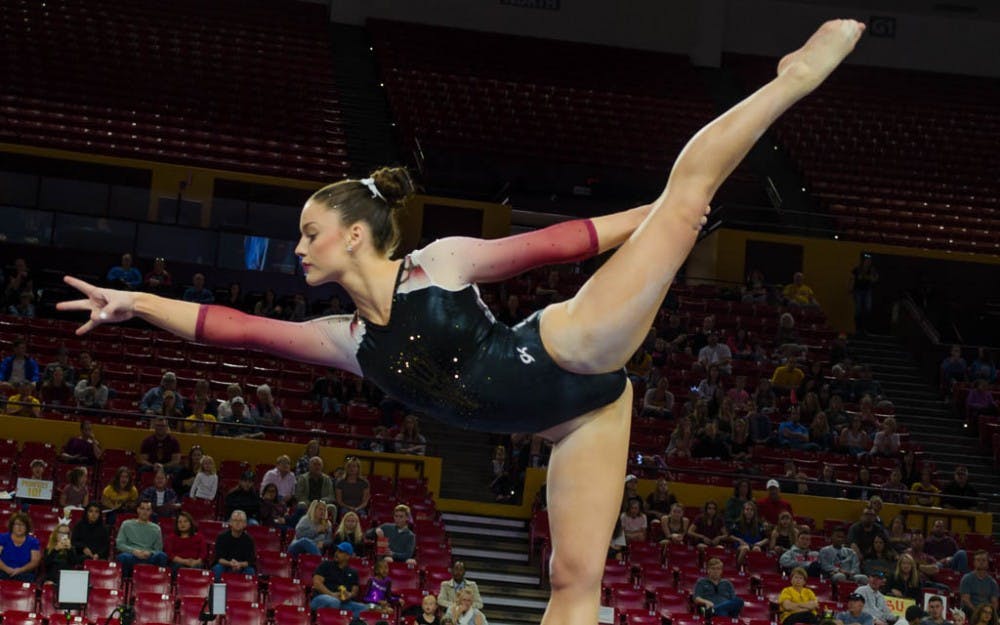Before and after puberty are the two time periods gymnasts reach peak skill level, and for ASU gymnasts, both are equally important to achieving success.
During the 2016 Summer Olympics in Rio, the average age for the U.S. women’s gymnastics team was 19, with Aly Raisman being the oldest at 22 and her teammate, Lauren Hernandez, barely breaking the age requirement at 16.
According to the International Federation of Gymnasts, all female gymnasts that compete in the Olympics must be at least 16 years of age or turning 16 within the calendar year.
Like many sports, gymnastics training begins at a young age, and those early years are a pivotal time to learn different skills and basic techniques. One of the most difficult things for both male and female gymnasts alike is having to adjust their skills once they hit puberty.
“It's hard because normally to be really successful in gymnastics you have to start really early,” senior Nichelle Christopherson said. “You’re expected to also peak really early, but as a girl, your body changes over time, and dealing with that is extremely difficult.”
Christopherson said that growing while competing in gymnastics is difficult because there needs to be constant adjustments in order to enhance technique.
"You just have to learn to pick it up,” Christopherson said. “You're expected to just pick it up really fast, and so I think that is probably one of the most difficult things to overcome.”
Sophomore Ashley Szafranski said that performing at the collegiate level has a completely different degree of intensity than youth competition.
“We work really really hard here, almost harder in a different way as you do when you're younger,” Szafranski said. “Sometimes, there's not that fear factor when you're very young. You're like ‘oh let's do anything,’ but I went through growth spurts a lot, so it was challenging. But I think you peak in a different way when you’re younger ... In college you still have those huge peaks in the beginning.”
Christopherson believes there are multiple periods in gymnasts' careers where they compete at their best.
“It's almost like you peak twice,” Christopherson said. “You peak when you're younger and then when your body changes you have to get all that back and you peak again.”
Szafranski said that during their youth, gymnasts learn a variety of skills, but when athletes reach college, they're focusing on what works for them and learning what their bodies can handle.
Christopherson noted that training at a young age is grueling, especially when working towards competing at an elite level, and it can be taxing on their bodies.
“That takes a toll on your body, in your ability to overcome that and being able to come back from those injuries,” Christopherson said. “I guarantee every person on this team has had a really bad injury in the past, and to come back from those in a short amount of time and to still be successful is really difficult.”
Beyond competing at a young age, some Sun Devil gymnasts competed on the Olympic level, a stage far different than collegiate gymnastics.
Junior Anne Kuhm competed in the 2012 Olympics for France and was an alternate for the team in the 2016 games.
“It's really different because I was competing for myself,” Kuhm said. "When we had international meets with the team, it was a team, but everyone was really focused on themselves, and now (at ASU) when you do your routine, it's for the team. Everything counts, and I think it brings more pressure because I want to do well for my team.”
Kuhm and her teammates agree that while everyone at the collegiate level has individual goals, they are all competing as one unit.
“I think when you’re young, you just go every day, you do the same thing every day and you work really hard every day," Szafranski said. "But here, you really realize that every single turn counts, every single conditioning thing counts and everything you're doing is not for yourself – it's for the team."
Reach the reporter at klbroder@asu.edu or follow @KellyB1459 on Twitter.
Like State Press Sports on Facebook and follow @statepresssport on Twitter.




